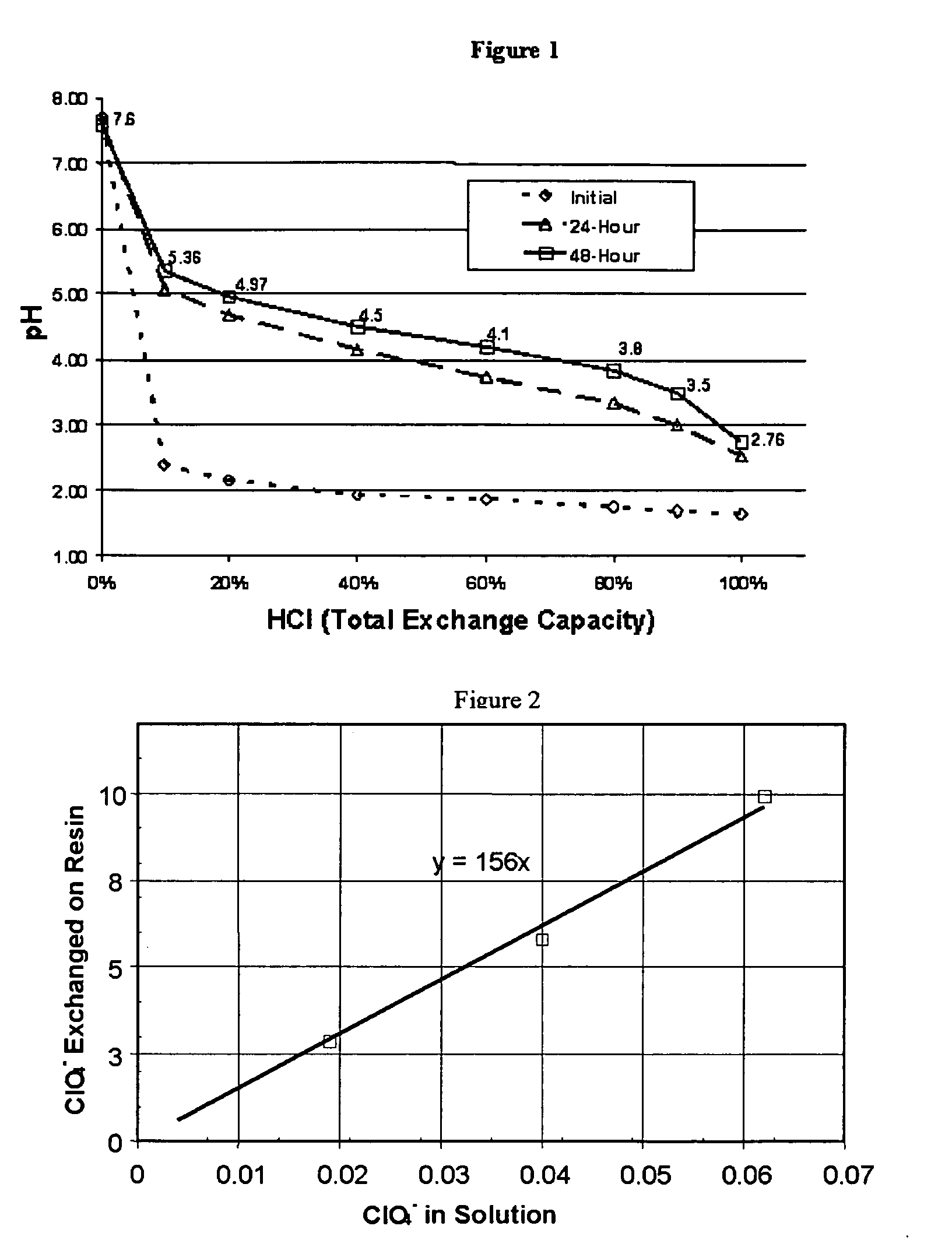Process for regenerating and protonating a weak-base anion exchange resin
a weak-base anion exchange resin and protonation technology, applied in the direction of ion exchangers, water/sewage treatment by ion exchange, separation processes, etc., can solve the problem of not being able to attract counter anions from solutions, and achieve high chemical efficiency, low cost, and high separation factor
- Summary
- Abstract
- Description
- Claims
- Application Information
AI Technical Summary
Benefits of technology
Problems solved by technology
Method used
Image
Examples
example 1
[0069]Treatment Capacity: FIG. 11 shows the results of a pilot column test conducted at 18 BV / hr and pH 4 on a groundwater containing approximately 2.1 mg / L perchlorate, 5 mg / L nitrate, 25 mg / L chloride, and 155 mg / L sulfate. The test was conducted in two, 2-inch diameter by 36-inch long columns connected in series. A perchlorate-selective, macroporous polystyrene-divinylbenzene WBA resin was used to attain a treatment capacity over 6,000 BV.
example 2
[0070]Regeneration: Rapid and complete regeneration was demonstrated by continuously flowing 5 BV of caustic regenerating solution followed by 10 BV of dilute caustic rinse water. The 5 BV of caustic regenerating solution contained 180% of the total estimated exchange equivalents (80% excess equivalents) of the macroporous polystyrene-divinylbenzene WBA resin tested and the rinse water was 0.01 Normal sodium hydroxide solution. FIG. 12 shows that the regenerating solution resulted in rapid regeneration using a very small volume of regenerating solution. Repeated regeneration, protonation, and ion exchange cycles demonstrated consistent mass recovery of 98% of the exchanged perchlorate.
example 3
[0071]Scavenging Regenerating Solutions. An ion exchange scavenging process was used to remove perchlorate from spent regenerating and rinse solutions. A strong base anion resin (Purolite A600) was used as the scavenger resin. Two liters of a macroporous polystyrene-divinylbenzene WBA resin was regenerated using 3 BV of caustic regenerating solution maintained at pH 12.5 by the addition of caustic. This solution was circulated through a perchlorate-loaded WBA resin column at a rate of 80 ml / min (5 BV / hr) as depicted in the regeneration frame of FIG. 10A. After 48 hours of circulation, the spent regenerant was collected and retained for subsequent scavenger resin treatment. The spent regenerant contained 163 miliequivalents perchlorate.
[0072]The WBA resin column was configured in series with scavenger resin vessels as depicted in FIG. 10C. Each scavenger column contained 90 cc of Purolite A600 resin. The rinse flow rate was 45 ml / min (30 BV / hour for each scavenger column and 1.35 BV / ...
PUM
 Login to View More
Login to View More Abstract
Description
Claims
Application Information
 Login to View More
Login to View More - R&D
- Intellectual Property
- Life Sciences
- Materials
- Tech Scout
- Unparalleled Data Quality
- Higher Quality Content
- 60% Fewer Hallucinations
Browse by: Latest US Patents, China's latest patents, Technical Efficacy Thesaurus, Application Domain, Technology Topic, Popular Technical Reports.
© 2025 PatSnap. All rights reserved.Legal|Privacy policy|Modern Slavery Act Transparency Statement|Sitemap|About US| Contact US: help@patsnap.com



